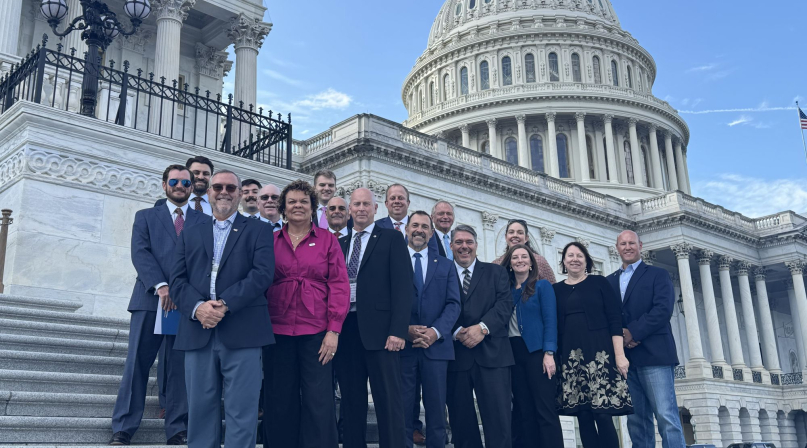Counties seek better formula for transportation funding
Upcoming Events
Related News

The federal shutdown has barely registered as a rumble strip as work continues on the next five-year surface transportation bill.
Both House and Senate committees are working to draft their bills, and both are committed to a member-driven process for figuring out how to get federal funding to where it is most needed. At the same time, Congress is fighting to overcome the Infrastructure Investment and Jobs Act’s (IIJA) reputation, which was dogged by systemic problems, members of the Local Officials in Transportation (LOT) Coalition said Oct. 21 as county officials prepared to visit Capitol Hill.
“I think [because of] the structure of IIJA, there were a lot of elected officials who thought they were just going to get money to be able to do projects, and so that rebounds also to members of Congress who also expected they would see a flow of resources into their districts in a similar fashion, for projects that they thought were also a priority,” said Erich Zimmermann, executive director of the National Association of Regional Councils (NARC).
Ben Gilsdorf, NACo associate legislative director for transportation, noted that the IIJA suffered for having followed the American Rescue Plan Act, which funded counties directly.
Twenty county officials conducted more than two dozen congressional meetings, advocating for more funding in the coming bill and a funding formula that will:
• give counties access to a share of the money that better reflects county infrastructure ownership
• reform the environmental review process
• preserve and improve discretionary grant opportunities, and
• improve the planning and project selection process
Providing funding through Regional or Rural Transportation Planning Organizations, they said, would help ameliorate disparities for areas with populations of more than 50,000.
Local Officials in Transportation includes NACo, NARC, the Association of Metropolitan Planning Organizations, the National Association of Development Organizations (NADO), the National League of Cities and the United States Conference of Mayors.
“The reality is that not much has changed in the landscape about how we think of the intergovernmental partnership that drives transportation infrastructure in this country,” said Jessica Monahan, a transportation lobbyist from Cozen O’Connor who represents several individual counties and previously staffed NACo’s Transportation Policy Steering Committee.
“In many respects, it’s a partnership in name only,” she noted. “Not much has changed in the talking points and the priorities, a lot has changed as far as who's staffing the committees on Capitol Hill,” and those staffers require constant education about the county position with regard to federal funding.
She echoed Zimmerman’s remarks on the current infrastructure bill.
“That was the largest investment that the federal government ever made in infrastructure,” she said. “It was supposed to be transformative. Why are there still so many problems? Why am I hearing from constituents that we have a bridge that can’t be opened, when we just put all of this money into our transportation infrastructure?
“The reality is that it’s not getting down to many communities that deserve it, need it and that it was intended to serve.”
There are more than 350 Rural Transportation Planning Organizations, but most are only locally recognized, said Mirielle Burgoyne, NADO’s deputy executive director.
“They’re not federally designated, and because they don’t have that federal designation, they don’t automatically get funding,” she said. “There is no source of automatic direct funding for rural areas to do transportation planning.”
She envisions a separate pot of funding.
“We know that a lot of these rural areas currently do already receive state planning and research funding, or they receive some sort of other state funding piecemeal to these rural areas, but it’s not dedicated direct, it’s not guaranteed,” she said. “It’s completely at the discretion of the state, whether those rural areas are receiving that funding.
“Rural planning, transportation planning, is already happening, but we just need to make sure that the resources that are there are sustainable.”
Fixing these flaws in funding will take feedback from the affected parties.
“I think that the broad-based package that we have put together collectively as a coalition, really speaks to some ways that I think the members of Congress can envision a way to a future where they can see some more success, both in the urban areas and in the rural areas for the types of projects that they are going to be prioritizing,” Zimmerman said.
Related News

House lawmakers introduce bipartisan legislation to support World Cup local transportation needs
On December 2, U.S. Reps. Rick Larsen (D-Wash.-02) and Burgess Owens (R-Utah-04) introduced the Transportation Assistance for Olympic and World Cup Cities Act (H.R.6348), a bipartisan effort to strengthen local transportation systems in communities preparing to host major international sporting events

County Countdown – Dec. 1, 2025
Every other week, NACo's County Countdown reviews top federal policy advocacy items with an eye towards counties and the intergovernmental partnership.

Federal district court issues ruling preventing the federal government from imposing immigration compliance mandates on grant recipients
On November 4, a federal judge in Rhode Island ruled that the U.S. Department of Transportation cannot condition federal grant funding on a recipient’s cooperation with federal immigration enforcement efforts.
County News
County News interviews Rep. Sam Graves (R-Mo.) Chair, U.S. House Transportation Subcommittee on Highways and Transit
